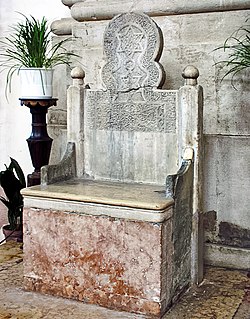| Basilica di San Pietro di Castello Basilica of St Peter of Castello | |
|---|---|
 The facade of San Pietro di Castello | |
| Religion | |
| Affiliation | Roman Catholic |
| Ecclesiastical or organizational status | minor basilica, parish church |
| Status | Active |
| Location | |
| Location | Venice, Italy |
 | |
| Geographic coordinates | 45°26′4.37″N12°21′35.47″E / 45.4345472°N 12.3598528°E |
| Architecture | |
| Architect(s) | Francesco Smeraldi, Andrea Palladio (design) |
| Type | Church |
| Groundbreaking | 7th century |
| Completed | 16th century |
| Specifications | |
| Direction of façade | WNW |
| Length | 75 metres (246 ft) |
| Width | 35 metres (115 ft) |
| Width (nave) | 16 metres (52 ft) |
| Website | |
| www.patriarcatovenezia.it | |
The Basilica di San Pietro di Castello (English: Basilica of St Peter of Castello), commonly called San Pietro di Castello, is a Roman Catholic minor basilica of the Patriarch of Venice located in the Castello sestiere of the Italian city of Venice. The present building dates from the 16th century, but a church has stood on the site since at least the 7th century. From 1451 to 1807, it was the city's cathedral church, though hardly playing the usual dominant role of a cathedral, as it was overshadowed by the "state church" of San Marco and inconveniently located. During its history, the church has undergone a number of alterations and additions by some of Venice's most prominent architects. Andrea Palladio received his first commission in the city of Venice from the Patriarch Vincenzo Diedo to rebuild the facade and interior of St Pietro, but Diedo's death delayed the project.
Contents
After St Mark's Basilica became Venice's official cathedral (it had previously been the private church of the Doge), San Pietro fell into a state of disrepair. It was firebombed during the First World War and only through the efforts of conservation organisations has it been restored to its former state. Its ongoing conservation is now managed through its membership of the Chorus Association of Venetian churches.
The church is located on San Pietro di Castello (from which it derives its name), a small island off the eastern end of the main city of Venice.






